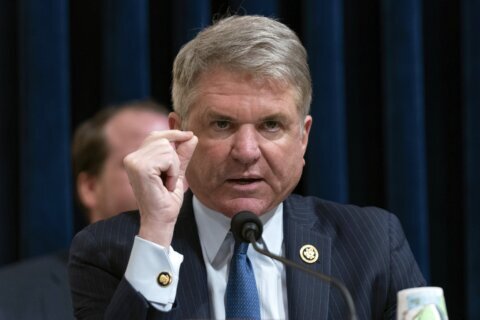MIAMI (AP) — For some Democrats, losing South Florida’s Miami-Dade County was unthinkable.
The state’s largest county in population and a Democratic stronghold, home to 1.5 million Latinos of voting age, has been a staging ground for virtually every successful statewide Democratic campaign for the last two decades.
But in Tuesday’s midterm elections, the GOP shattered the Democrats’ Miami-Dade firewall, raising questions about their ability to compete in future statewide elections — including the 2024 presidential race — as Republicans expand their coalition in a way that could echo beyond Florida.
With the final votes still being counted, Florida Gov. Ron DeSantis and Sen. Marco Rubio defeated their Democratic opponents by close to 20 points. In Miami-Dade specifically, their wins could ultimately touch double digits.
DeSantis even won among college-educated and suburban voters, cutting into what was a core Democratic strength elsewhere.
“Our party, especially here in Florida, needs to take a step back to make sure this never happens again,” said Rep.-elect Maxwell Alejandro Frost, a 25-year-old Democrat who is Black with Latino heritage. He won his central Florida congressional race on Tuesday but lamented GOP gains elsewhere across the state.
Florida Republicans, meanwhile, were ecstatic.
“The Florida Democratic Party has completely collapsed,” said Giancarlo Sopo, a Republican strategist. “This wasn’t just a wave or a tsunami. It was a red asteroid that hit them in Florida.”
The GOP’s success in Florida stands in stark contrast with seeming disappointments for Republicans elsewhere on Tuesday. While votes were still being counted in several key races, the red wave that Republican leaders predicted did not materialize in most of the country. Some of former President Donald Trump’s hand-picked candidates did especially poorly.
Trump did not endorse DeSantis, whom Trump sees as a potential rival in the 2024 presidential contest. Days before the election, Trump mocked DeSantis as “Ron DeSanctimonious” and excluded him from a Florida rally.
But for this week, at least, DeSantis had a decided edge in the rivalry.
The New York Post, Trump’s favorite hometown newspaper, put DeSantis on Wednesday’s front page with the headline, “DeFUTURE.”
“I think people feel not great about the Trump brand right now,” said David Urban, a former Trump adviser and Florida resident.
But beyond the Trump-DeSantis shadow primary, Florida’s evolution from perennial swing state to trending Republican stronghold was stunning.
DeSantis won the governor’s office four years ago by 32,436 votes out of more than 8.2 million cast, a margin so narrow that it required a recount. As the final votes were being counted on Wednesday, his lead exceeded 1.5 million votes. DeSantis’ margin of victory was set to exceed the margins of Florida’s last four governor’s races combined.
The Florida GOP has benefited from an influx of Republican voters moving to the state during the Trump years. In the four years since DeSantis was elected, Republicans have erased a voter registration advantage that Florida Democrats had guarded for decades. When registration closed for the 2018 election, Democrats enjoyed a 263,269-vote advantage. At the end of September, Republicans had a lead of 292,533 voters.
At the same time, about three-quarters of Florida Republicans identify as a supporter of the Make America Great Again, or MAGA, movement, according to AP VoteCast, a survey of more than 3,300 voters in Florida. That’s significantly higher than the roughly two-thirds of Republicans nationally who say the same.
Central to those gains is the shift among Latino voters.
More than half of Florida’s Latino voters went for Republicans DeSantis and Rubio over Democrats Charlie Crist and Val Demings, AP VoteCast found. That’s a shift from 2020, when Latino voters leaned toward Biden over Trump.
The Latino vote in Florida is more complex than many other parts of the country, a blend of Cuban Americans, Puerto Ricans and other Hispanics. Cuban voters, notably older ones, had already securely been in the GOP’s corner, with Trump earning about 6 in 10 voters in 2020. This year, DeSantis earned a whopping three-quarters of Cuban voters.
Yet DeSantis did relatively well among most voting blocs.
The Florida governor made modest gains even among Black voters, who continue to back Democrats overwhelmingly; 18% of Black voters in Florida backed the Republican. He was supported by both men and women and voters across age groups. Majorities of college graduates and suburban voters supported him. Moderate voters split about evenly between DeSantis and Crist.
Lilly DeLisi, a Puerto Rican voter who identified as liberal before Trump launched his candidacy in 2015, said she supports whoever she thinks has a better handle of the economy as the country reels from record-high inflation. She was supportive of DeSantis.
“I don’t have to love who’s in charge,” DeLisi said. “Just to know that my dollar is going to go farther and that my gas and my money won’t be stretched so far, then I am going to vote for that person.”
Indeed, it’s unclear whether the GOP’s gains with Latino voters are part of a fundamental shift in Florida or an anomaly related to a difficult political environment for Democrats. The Florida GOP’s success did not necessarily play out in other states like Texas, where Republicans were equally bullish.
Juan Martinez, an adviser for the conservative Libre Initiative, said he continues to regard the Latino vote as a swing-vote community that can move in any direction in future elections. Latino voters, he said, require year-round attention to deliver political victories.
“One day they can vote Republican, the next election they can vote Democrat,” Martinez said. “Educate on issues. Forget about the drama in Washington, D.C., and the division. They want real solutions.”
National Democrats, meanwhile, have signaled little interest in competing for Latino votes in Florida. National campaign committees over the last year largely ignored the state, which is among the most expensive from a campaign perspective.
Florida Democratic strategist Jose Parra called on his party to do some “soul searching.”
“They need to think about whether they are going to concede Florida forever,” he said. “To me, that’s ludicrous given the fact that we were the largest swing state in the country, and the path to the White House for Republicans was impossible without Florida.”
“Instead of throwing up their hands,” Parra said, “they should make a long-term investment.”
___
Peoples reported from Washington. Associated Press writers Hannah Fingerhut and Nuha Dolby contributed to this report.
___
Follow the AP’s coverage of the 2022 midterm elections at https://apnews.com/hub/2022-midterm-elections. And learn more about the issues and factors at play in the midterms at https://apnews.com/hub/explaining-the-elections.
Copyright © 2024 The Associated Press. All rights reserved. This material may not be published, broadcast, written or redistributed.







